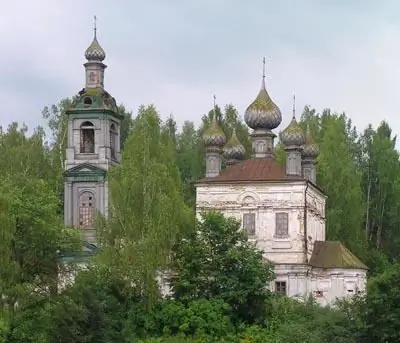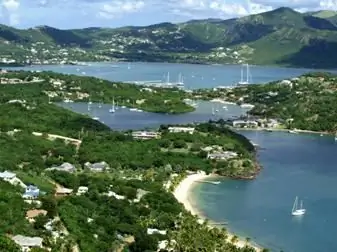- Author Harold Hamphrey [email protected].
- Public 2023-12-17 10:06.
- Last modified 2025-01-24 11:10.
Kungur is located in the south-east of the Perm Territory. The sights of this city can surprise even the most sophisticated traveler. After all, there are a huge number of both natural and man-made objects that are worth seeing. Moreover, getting to Kungur is quite simple, since the city is crossed by two highways - Perm - Yekaterinburg and Perm - Solikamsk, the Trans-Siberian Railway, as well as the railway.

History of Kungur
The city was founded in 1648, and the place is the Kungurka River. In 1662, the settlement was destroyed due to the Seit rebellion, and in 1663 Tsar Alexei Mikhailovich ordered to restore it, but already in a new place, namely at the confluence of two rivers - the Sylva and the Ireni.
Convenient location contributed to the fact that the city became the trade and administrative center of the region, and after sometime - the center of the Perm province. In the 19th century, Kungur was a large merchant city; it was unofficially called the "tea capital of the Russian Empire." During this period, many merchants lived here, with whose money those sights of Kungur were built, which today are presented to the eyes of residents and guests of the city. These are churches, and estates, and schools, and colleges, and guest houses, and much more.
Churches of Kungur
Starting from the time of the founding of Kungur, it has always been considered the center of the Orthodox culture of the Kama region. He retained this status to this day. Now 4 Orthodox churches (Nikolskaya, Preobrazhenskaya, Tikhvinskaya and All Saints) have Kungur on its territory. The sights of this direction will be of interest to both religious personalities and connoisseurs of architecture.

Tikhvin Church was built in the 18th century at the expense of the voivode Yu. A. Matyunin. The temple is a stone baroque five-domed double-height building. The chetverik and the entablature of the architraves are decorated with a cornice with a "beetle" frieze. At the end of the 19th century, the church was rebuilt thanks to the donations of A. S. Gubkin, who was a Russian tea merchant. At the end of the 20th century, the Tikhvin Church was converted into the Oktyabr cinema, but today the church is functioning, and Orthodox Christians living in Kungur can pray in it.
Sights of the city also include the Transfiguration Church. It is the only shrine on the territory of the region, which is crowned with a "baptized"five domes. This temple was built in the period from 1768 to 1782 at the expense of I. M. Khlebnikov, who died in 1774 defending the city from the troops of Pugachev. At the moment, the temple is fully operational.
Seating courtyards of the city
The city of trade and merchants - this is the status that Kungur has been endowed with for a long time. The sights that can be seen today on its territory confirm this. We are talking about the gostiny yards of the city. There is a building on the Cathedral Square, which was erected in 1865-1876. It is presented in the form of a closed polygon, which along the perimeter is filled with shopping arcades. In the architecture of the building, the style of classicism with a touch of eclecticism can be traced. On the outside of the Gostiny Dvor there is a covered gallery, and inside there is a playground where people often walk who, for one reason or another, arrived in Kungur.
Sights of the city also include the Small Gostiny Dvor, which was built in 1872-1874 in the eclectic style with elements of Old Russian style and oriental motifs. Now the building houses the Museum of the History of Merchants.

Old educational institutions of the city
While looking at the sights of Kungur (Perm Territory), one cannot ignore its educational institutions, which were built in different periods of time. So, in 1878, the merchant A. S. Gubkin built the Elizabethan needlework school. The merchant built the establishment in memory of his daughter Elizabeth, who passed away very early. The school wasis intended for the education and upbringing of orphans. Since 1926, the building has been a teacher training school, and now it is a college of industrial technology, management and design.
In 1877, a technical school appeared in the city, the building of which was equipped with all the novelties and amenities of that time - Dutch ovens, a ventilation system, etc. The school studied physics, mathematics, technology, chemistry, drawing, and also made various products, including machine tools, drills and much more. Now there is a motor transport college here, but it is also interesting for tourists, since its building is included in their list of Kungur sights. A photo of this educational institution can be seen below. In addition, guests of the city should visit the four-year and real schools.
Estates and mansions of Kungur
For several hundred years, many merchants lived in the city of Kungur. Attractions for this reason now include a huge variety of estates and mansions, which at one time were erected by one or another person.

So, in 1927, S. I. Gubkin organized a manor, on the territory of which there was a wooden house, an outbuilding, a barn, stables and a bathhouse. After the death of his father, his son A. S. Gubkin in the 1860s-70s erected a new stone house on the site of the old house, which can still be seen today.
Especial attention deserves the estate of the merchant E. Ya. Dubinin, the construction of a mansion on the territory of whichbegan in 1883. The building was made in the style of brick eclecticism. A mezzanine with a pediment was erected in the center of the house, the latter was supplemented by a balcony. Nearby is the Tikhvin Church.
In addition to those already mentioned, the mansions of V. A. Shcherbakov, M. I. Gribushin, G. K. Kuznetsov, A. P. Chuloshnikov, N. I. Kovalev and many other merchants who previously lived on territory of the city of Kungur. Sights of this kind will especially interest lovers of history and connoisseurs of architecture.
Natural beauty of Kungur
However, the numerous man-made sights of Kungur are not the only thing rich in the city. On its territory and in the vicinity there are many natural beauties - rivers, lakes, hills. But the Kungur Ice Cave, which is the first in Russia equipped for tourists to visit, deserves the most attention. This natural attraction is located in the north-eastern part of the city, in Ice Mountain, which is located between the Iren and Shakva rivers.

At the moment, 5.7 km of the cave are explored, but the excursion route is only 1.5 km. Under the ground there are 60 lakes filled with crystal clear water. About 100,000 people visit the cave every year. It is possible that soon the object will be included in the UNESCO heritage list, as this issue is already being discussed.






